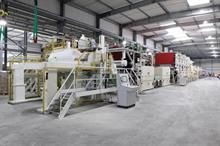
The melt blowing process is also used for other products like furnace filters, coffee filters, and diapers. By using Argonne supercomputing resources to pair computational fluid dynamics simulations and machine-learning techniques, the Argonne and 3M collaboration, supported by the DOE’S High Performance Computing for Energy Innovation (HPC4EI) programme, sought to reduce energy consumption by 20 per cent without compromising material quality.
The initial model for the melt-blowing process was developed through a series of simulation runs performed on the Theta supercomputer at the Argonne Leadership Computing Facility (ALCF) with the computational fluid dynamics (CFD) software OpenFOAM and Converge. The ALCF is a DOE Office of Science user facility located at Argonne.
Currently, the process used to create a nozzle to spin nonwoven materials produces a very high-quality product, but it is quite energy intensive. Approximately 300,000 tons of melt-blown materials are produced annually worldwide, requiring roughly 245 gigawatt-hours per year of energy, approximately the amount generated by a large solar farm.
The melt blowing process uses a die to extrude plastic at high temperatures. Finding a way to create identical plastic components at lower temperatures and pressures motivated the machine-learning search, said Argonne computational scientist Benjamin Blaiszik, an author of the study.
By using simulations and machine learning, Argonne researchers can run hundreds or even thousands of use cases, an exponential improvement on prior work. “We have the ability to tweak things like the parameters for the die geometry,” Blaiszik said. “Our simulations will make it possible for someone to make an item at an actual industrial facility, and our computer can tell you about its potential for real-world applications.”
The simulations provide key insights into the process, a method to assess a combination of parameters that are used to generate data for the machine-learning algorithm. The machine-learning model can then be leveraged to ultimately converge on a design that can deliver the required energy savings.
Because the process of making a new nozzle is very expensive, the information gained from the machine-learning model can equip material manufacturers with a way to narrow down to a set of optimal designs. “Machine-learning-enhanced simulation is the best way of cheaply getting at the right combination of parameters like temperatures, material composition, and pressures for creating these materials at high quality with less energy,” Blaiszik said.
Fibre2Fashion News Desk (NB)

